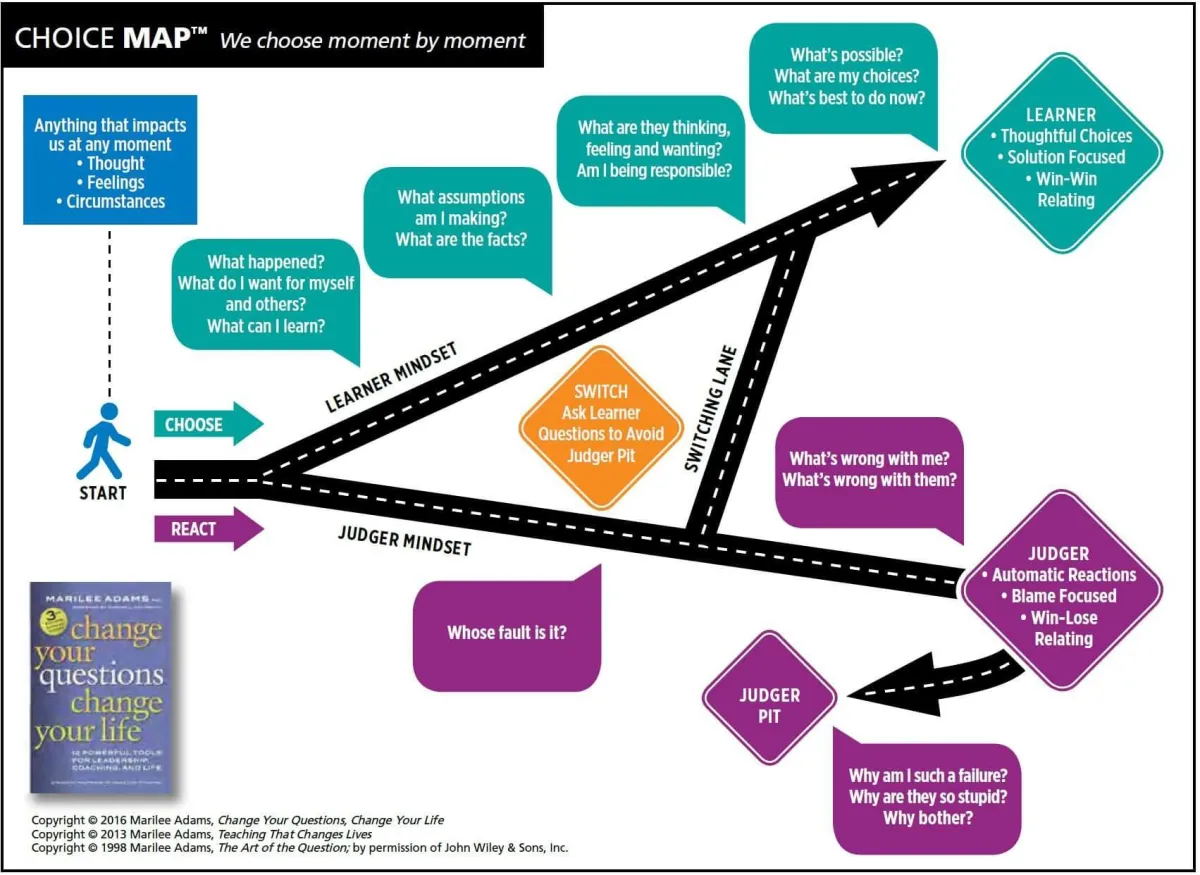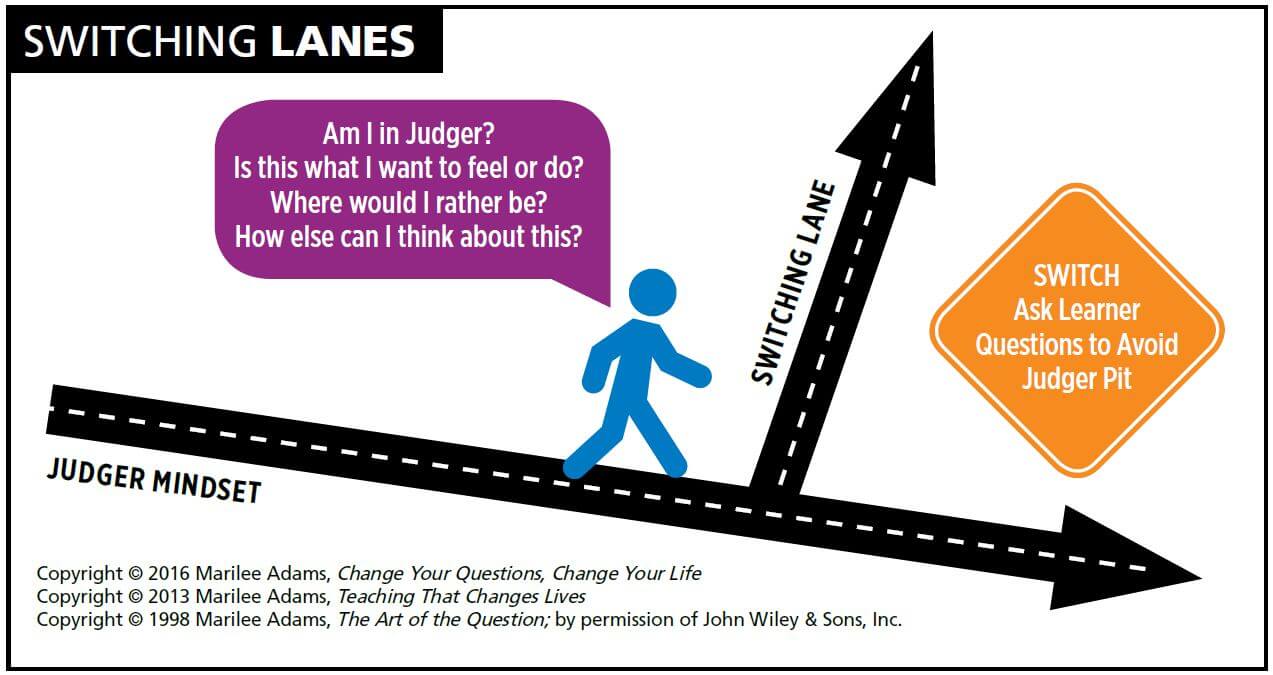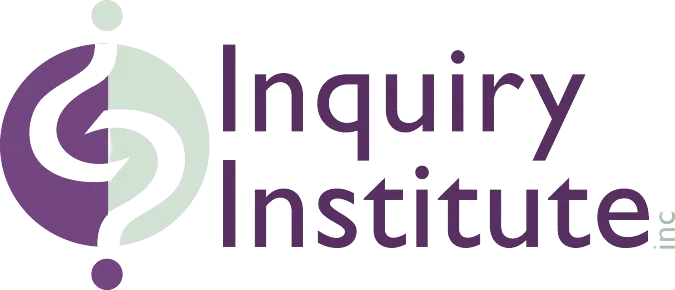Blog

Mindsets & Questioning
Every coach knows that the questions we ask clients largely determine coaching success. We intuitively understand that “a question not asked is a door not opened.”1 But how confident, comfortable and skillful are we at coming up with those seemingly magical questions? How intuitive are we at predictably generating questions that cause clients to stop in their tracks and exclaim, “Wow, I never thought about it that way before!”
As a coach, it’s logical to think that learning about great questions means focusing on the question it- self. But that’s only part of the story. Beyond the practices of questioning, what’s essential is the question asker, the source of those life-changing questions. And for that, the mindset of the coach makes all the difference. It’s about cultivating the mindset from which great questions arise.
CHOICE MAP AS COACHING TOOL
The Choice Map is practical in several important ways. Our ability to distinguish between Learner and Judger mindsets helps us become more aware in general and better observers of ourselves and others.
Eventually, we’re able to simply ask ourselves at any moment, “Where am I on the Map right now?” or “Am I in Judger or Learner?” If asking “Am I in Judger?” make sure you’re asking non-judgmentally!
Additionally, the imagery of the Choice Map provides common language, a kind of shorthand for communicating. I often ask clients (in-person or virtually), “With this person or situation, where would you say you are on the Choice Map?”
Another practical, even transformational aspect of the Choice Map, is the moment by moment “how to” it provides for switching from Judger to Learner, as illustrated by the Switching Lane. Taking the Switching lane becomes highly intuitive once we’ve caught onto the practice. It begins with waking up from the trance of Judger by asking “Am I in Judger?” We follow up with Switching questions such as: “Is this what I want to think or feel?” “Is this how I want to be communicating?” or perhaps, “How else can I think about this?” As we practice self-observing and asking Switching questions, we cultivate the resilience and possibilities that come alive with Learner. This is what Carol Dweck means when she writes about changing “… from a judge-and-be-judged framework to a learn-and-help-learn framework.”
Let’s revisit the Learner mindset as the coaching mindset. Imagine you’re preparing for a coaching session and find yourself in Judger, thinking, “What irrelevant things will she/he bring up this time?” Noticing your Judger, you switch by wondering what Learner thinking would help you better serve your client. You come up with a new question, “How can I invite her/ him to stay more focused on their real agenda?” This shift will impact your coaching presence as well as how you listen, connect, and communicate.

Each time we switch to our “Learner self,” we reinforce the first two pillars of emotional intelligence (self-awareness and self-management/ self-regulation). We recover from an amygdala hijack–-those moments when our fears catapult us into Judger, which I call a “Judger hijack”—by asking Switching questions, thus returning yet again to Learner mindset territory. This also reinforces the principles of appreciative inquiry, strength-based thinking, and positive psychology.
By learning to mindfully “accept Judger and practice Learner” and asking Switching questions, we’re literally taking advantage of neuroplasticity—our brains’ innate capacity for learning and change.
This reinforcing of Learner makes a difference in neuroplasticity. As Rick Hanson instructs, “Your brain takes its shape gradually from what you routinely rest your mind upon.”7
QUESTIONING & CHOICE MAP
An aligned term for Learner mindset is “Inquiring mindset.” When we’re in Learner, we’re continually curious, naturally asking many questions of ourselves and others. By shifting from an “opinion and statement way of being” to a “curiosity and questioning way of being,” we’re simultaneously cultivating the mindset from which great questions arise.
Notice that the questions in the thought bubbles of the figures on the Choice Map are in the form of internal questions, which I call Question Thinking. By becoming facile with recognizing the power of mindsets and the internal questions associated with them, coaches can significantly enhance the quality, quantity, and impact of the questions they ask clients.
SUMMARY
The focus on the twin engines of mindsets and questioning can complement any coach training and coach approach. Operating with curiosity and caring, the more coaches become aware of their own mindsets and develop the capacity to “live from Learner,” the more deeply they cultivate the mindset from which their own great coaching questions can arise.
Staying in Learner mindset and engaging in the practice of asking ourselves one question – “What do I want my question to accomplish?” – helps coaches cultivate the skills for coming up with those transformational questions that make all the difference in our clients’ success.
REFERENCES
1 Adams, Marilee (Goldberg). The Art of the Question: A Guide to Short-Term Question-Centered Therapy. John Wiley
& Sons, Inc. Publishers, New York. 1998.
2 Adams, Marilee. Change Your Questions, Change Your Life: 12 Practical Tools for Leadership, Coaching, and Life (3rd edition). Berrett-Koehler Publishers, Inc., Oakland, CA. 2016.
3 Ibid.
4 Ibid.
5 Ibid.
6 Dweck, Carol S., Mindset: The New Psychology of Success. Random House Publishers, New York. 2006.
7 Hanson, Rick. Just One Thing: Developing a Buddha Brain One Simple Practice at a Time. New Harbinger Publications, Inc. Oakland, CA. 2011
Published in, and reproduced with permission from, choice, the magazine of professional coaching www.choice-online.com

Learn More

